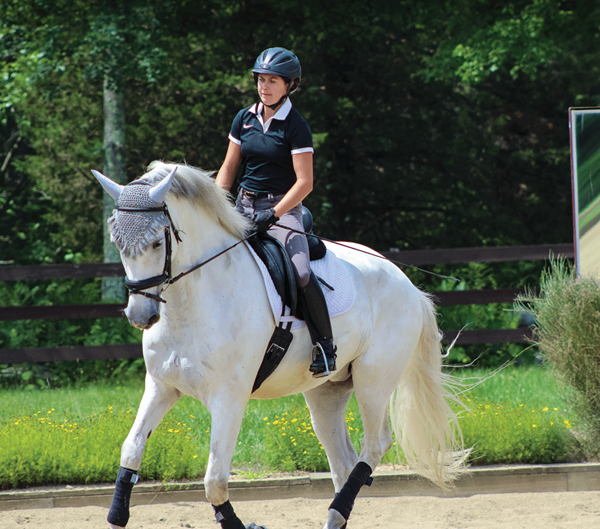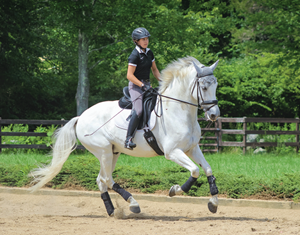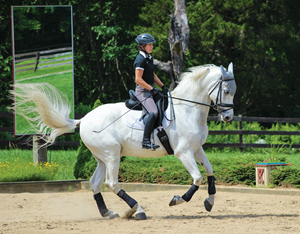Stay dedicated to the quality of the basic gaits—the suppleness and balance of the walk, trot and canter. Then as you cultivate the movements, those gaits improve. Here’s what to look for every day:
In the walk, you want a combination of purpose and calmness. Do not sightsee in the walk. Rather, you want to try to “catch the next bus without running.”
In both the trot and canter, you want to feel that your horse is taking you along into the next stride because he is in front of the leg, his back swings and he’s balanced.
In all three gaits, the keys are rhythm, suppleness and a readiness for the horse to answer the next aid or request immediately.

Teaching horses is like making a rum cake. When you make a rum cake, you need time to let the rum soak in. It’s the same when teaching a horse because he can only learn so fast. If the rider is inclined to teach too fast and drill the same thing again and again, the horse’s muscles get tired. Teaching a skill is a matter of using a timeline. If I teach a skill this week, I don’t expect it to be perfect next week. I allow the horse to absorb the lesson.
For example, in teaching your horse the aids for left bend, part of the signal is to bring your right leg back. If the horse doesn’t respond, I don’t keep bugging him about it. If he doesn’t bend after five times, what are my chances of getting it after 15 times? I leave it alone or find a different approach so I don’t make the horse dull. Ask your horse, but don’t drill him. Give him time for the lesson to soak in and try again tomorrow.
Use clear aids. Some riders inadvertently give three different signals for the horse to do the same thing. How many hand signals do you give when you want your dog to sit? One. To use the same left bending example, if my horse doesn’t respond to my normal outside leg aid and I kick him, then I’ve used a different aid. That’s a special aid used to get the horse’s attention. Then I return to the exact same normal signal with clear aids, and my horse understands more easily. Only use the special aid to make him more alert.
Reward your horse when the work is hard. When you ask your horse for extra effort and he tries hard, be sure to reward him at that moment. I don’t mean hug him and give him sugar. I mean let the horse know how good he is when he’s trying hard.
When I rode with Walter Christensen and Klaus Balkenhol, they worked me hard. I remember thinking, Oh, my God, I think my legs are going to fall off. But then when I heard, “Good! Great! There you go!” the pain went away. They cheered for me.
The horse needs to feel that we cheer for him when he tries hard. Yesterday I asked a horse for two or three short trot steps, the beginning of piaffe. He did it, and I made a big deal about it. I asked for the same thing today, and he did it more by himself.
You can’t force a horse to move like a 10. Horses move best if you explain what you want and don’t force it. If your horse isn’t a big mover, he just needs to understand his job. Sometimes riders work too hard to get that big result, pushing the horse past his rhythm and tempo. You’ll get positive feedback when the work looks easy. Avoid making the common mistake of racing around in the name of forwardness.
Think positively toward your horse. Your horse feels your positive attitude toward him. Don’t plan on anything going wrong and if your horse makes a mistake, don’t consider it something wrong. The horse just didn’t quite understand yet.
Nerves are OK. If you never get nervous, there’s something wrong. You might not care enough. You need a little nervousness that will turn into either success or a learning experience. Nerves should enable us, not disable us.
Stay focused on your game. You can’t change your golf swing the night before the big tournament. If you find yourself in the competition warm-up admiring a great rider on a beautiful horse floating along the ground, don’t change your program. Stick to your game and do what your horse can do. When the curtain opens, you just need to say, “Look, this is what we can do today.”
If you ride well, your horsemanship and your basics are correct and the test is accurate, then you’re going to be rewarded and be competitive.
Try these Exercises to Develop a Sense of Readiness
Your horse’s positive reaction to light aids improves the balance and the quality of his gaits. That rhythmic eagerness gives him swing in the back and a positive, elastic tension in the rein. Tailor the following exercises to the lower-level horse by using working gaits and lengthenings. For the more educated horse use collected and medium paces.
Exercise 1
1. Begin by tracking right. Go from M to R in the medium walk.
2. At R, pick up working trot.
3. At P, transition to medium walk. Feel that you can make your down transition with forward aids rather than bring him back with too much hand.
4. At F, transition to working trot, riding energetically through the short side.
5. At K, do another forward-thinking transition to medium walk.
6. By now your horse is eagerly expecting to do transitions. As you approach V, your horse will expect to trot, but ride a transition to extended or free walk on the diagonal to change direction.
7. As you approach M tracking left, shorten your reins and go to a medium walk in a forward way.
8. Do the same exercise on a 20-meter circle. Do it with trot–canter–trot transitions. Through these simple transitions, you instill readiness in your horse.
Exercise 2
1. Start on a 20-meter circle in trot.
2. Lengthen the stride slightly for a half circle.
3. Shorten the stride and at the same time make the hind legs quicker with your leg or whip.
4. Lengthen the stride again for a half circle.
5. Repeat the shortening of the stride and at the same time make the hind legs quicker.


Your horse’s movement becomes more expressive because his hind legs carry him with uphill balance into the lengthenings and they take more weight during collection. Do the same exercise in canter. These simple exercises lead to a forward-thinking horse not only in upward transitions but also in down transitions. That forward-thinking quality improves the horse’s balance as he becomes more aware of how to use his hind legs in all situations. He always has the desire to go actively into the next gait or transition.
Volker Brommann became a licensed Bereiter in 1980 in his native Germany and earned his Pferdewirtschaftsmeister in 1988. He was one of the first USDF Certified Instructors at the FEI level in the U.S. He and Jennette Scanlon live with their sons, Dylan and Mattias, in Auburn, California. Brommann is in demand as a clinician throughout the U.S. (volkerbrommann.com).











